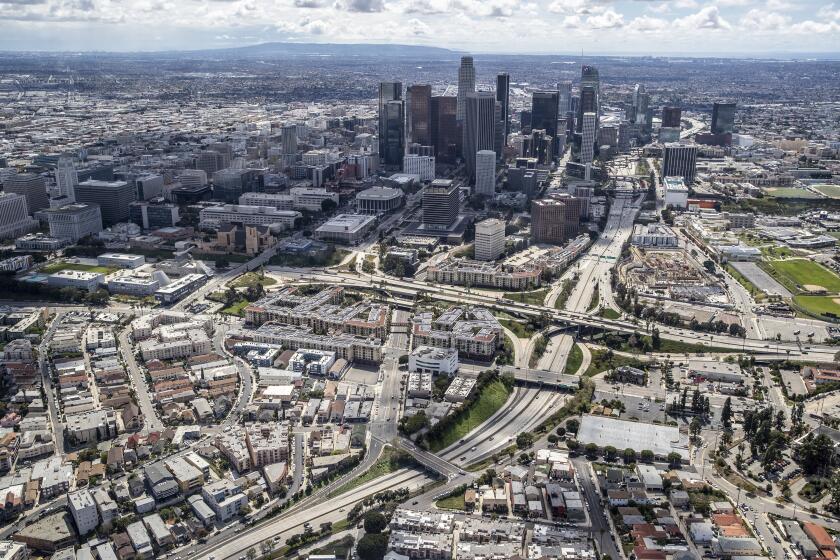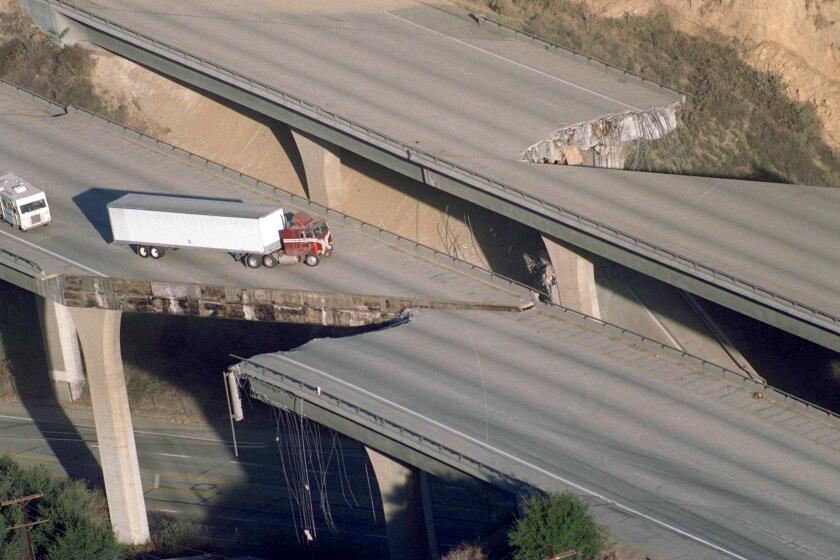Can this landmark L.A. skyscraper survive a major quake? County officials want to find out
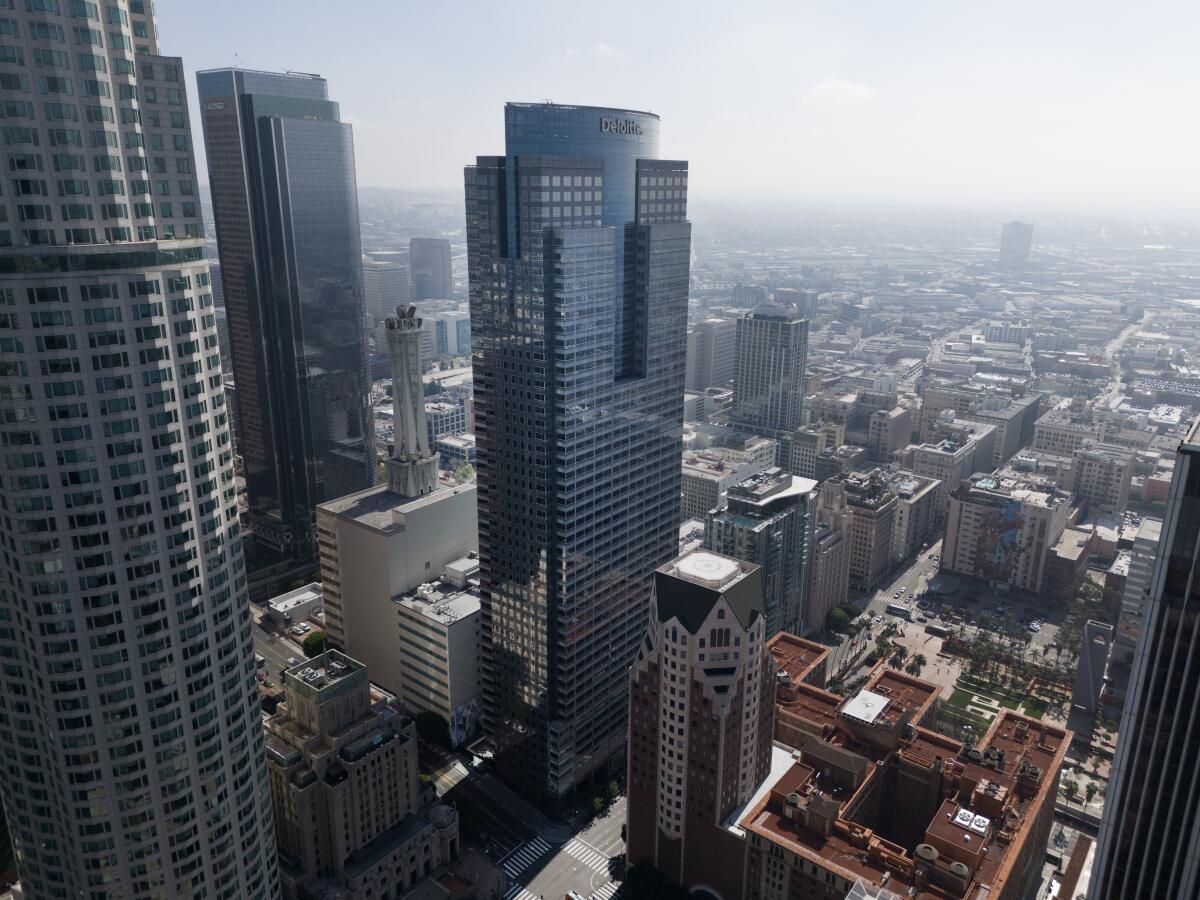
- Share via
On paper, the deal makes sense.
Faced with the prospect of an extensive, and expensive, seismic safety retrofit for its 1960s-era downtown headquarters, L.A. County decided to vet an alternative: a far newer building, located just blocks away. Not only was it built under stricter standards, the reasoning goes, but it was available at a massive discount compared with its pre-pandemic price tag.
But the possible move to the Gas Company Tower is far from official. And before putting pen to paper on the deal, officials want to assess just how seismically safe the skyscraper really is.
The scrutiny underscores the growing understanding of the structural weaknesses of many buildings across Los Angeles, which has fueled a steady cadence of regulation requiring potentially vulnerable structures to be strengthened or demolished.
Officials have identified 33 buildings owned by Los Angeles County as having a flaw that could cause them to collapse in a major earthquake.
Many of those rules, and much of the policymaking attention, has focused on older buildings or those fashioned from materials known to be susceptible to shaking — such as unreinforced brick or nonductile concrete.
The Gas Company Tower is different, though. It’s relatively modern, completed in 1991, and fashioned out of steel.
But, as the 1994 Northridge earthquake demonstrated, common types of steel-framed buildings still can be severely damaged during stronger earthquakes. During that magnitude 6.7 temblor, 25 steel-moment-frame buildings were significantly damaged, including the Automobile Club of Southern California building in Santa Clarita, which almost collapsed.

More concerning still is the fact that the earthquakes of the last half a century haven’t been a true test of the kind of shaking that’s possible where California’s tallest buildings reside. Neither downtown Los Angeles nor San Francisco have experienced “severe” shaking from an earthquake since the era of steel skyscrapers began in the 1970s, based on shaking intensity definitions as defined by the U.S. Geological Survey.
Other L.A. County cities — Torrance, Santa Monica and West Hollywood — generally require buildings such as the Gas Company Tower to be seismically evaluated and retrofitted, if necessary. The city of Los Angeles does not.
Our understanding and preparedness have come a long way since Northridge’s magnitude 6.7 earthquake in 1994. We’re still learning from that destructive temblor.
But seismic engineers are conducting an “in-depth evaluation” to determine whether the Gas Company Tower, the fifth-tallest member of the downtown skyline, has vulnerabilities that need to be addressed, according to an L.A. County spokesperson.
“Those issues are exactly what we are exploring through our due diligence,” the county said in a statement. “Without getting ahead of the work currently underway, one factor is assessing how this building would perform compared to the performance of the Hall of Administration, and the respective costs of each approach.”
The county has submitted a nonbinding letter of interest for the 52-story, 749-foot-tall building, though the Board of Supervisors still must approve the deal.
With little demand for downtown office space, the county plans to pay $215 million — a significant discount from the more than $600 million it was appraised at before the pandemic. But that price doesn’t include any potential costs for a retrofit.
SoCalGas will leave its namesake Gas Company Tower in downtown L.A. and move a block north to another skyscraper, at 350 S. Grand Ave.
The tower, at 555 W. 5th St., was completed with stronger earthquake standards than one of the buildings it probably would replace: the nearby Kenneth Hahn Hall of Administration, which was finished in 1960.
The Hall of Administration is the headquarters of the nation’s most populous county — home to its top elected officials: the five-member Board of Supervisors. The sprawling building is located in the Civic Center, about three-fifths of a mile northeast of the skyscraper.
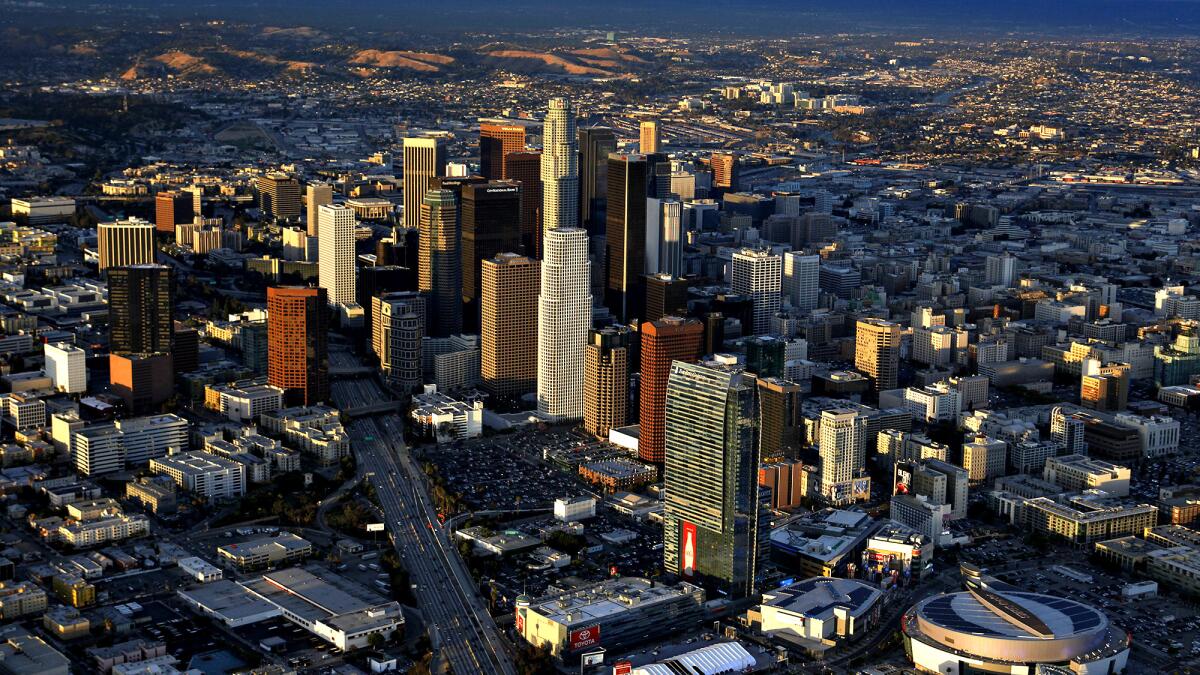
But like its decades-older neighbor, the Gas Company Tower still may need seismic work.
It is one of many L.A. skyscrapers that incorporates a steel moment frame as part of its structural system. Such frames are made up of horizontal beams and vertical columns, and feature a largely rectangular skeleton. Steel moment frame buildings rely on the connections between horizontal beams and vertical columns to stay intact during earthquake shaking, keeping the skeleton of the building together.
(Steel moment frames are different than steel-braced frames, which add in diagonal braces to create triangular shapes. Triangles are stiffer than rectangles and strengthen the overall skeleton. Steel-braced frames bend less in an earthquake than steel moment frames.)
It’s been an unusually active year for earthquakes in Los Angeles, as Thursday morning’s magnitude 4.7 Malibu temblor shows.
Steel moment frames were discovered to be potentially problematic after the Northridge earthquake, which killed at least 57 people. No building with this architecture collapsed or took lives, but some were so badly damaged they had to be demolished.
Among the flaws in pre-Northridge-temblor steel moment buildings were problems in welding technique and inspections, the filler metal used in the welds as well as the basic configuration of the connections between vertical columns and horizontal beams. After the earthquake, changes in construction methods were implemented to resolve such problems.
For steel moment frames, Northridge “showed us that the connections were susceptible to damage,” said David Cocke, a former president of the Earthquake Engineering Research Institute and co-founder of the Gardena-based structural engineering firm Structural Focus.
In a worst-case scenario, a steel moment frame building would collapse during a strong earthquake, although that hasn’t happened in the United States.
It remains unclear how vulnerable the Gas Company Tower is, and experts say figuring that out would require further study. Generally speaking, concrete buildings that need retrofits — such as the Hall of Administration — are far more vulnerable than steel buildings that need seismic strengthening.
After a Times investigation, Los Angeles building officials commit to hiring an auditor to review building database.
The Gas Company Tower doesn’t rely only on its steel moment frames to resist earthquakes, said Prabodh V. Banavalkar, the building’s structural engineer. Rather, it uses a dual structural system that incorporates a braced core. That design reduces strain on connections between horizontal beams and vertical columns that are tested by an earthquake’s shaking.
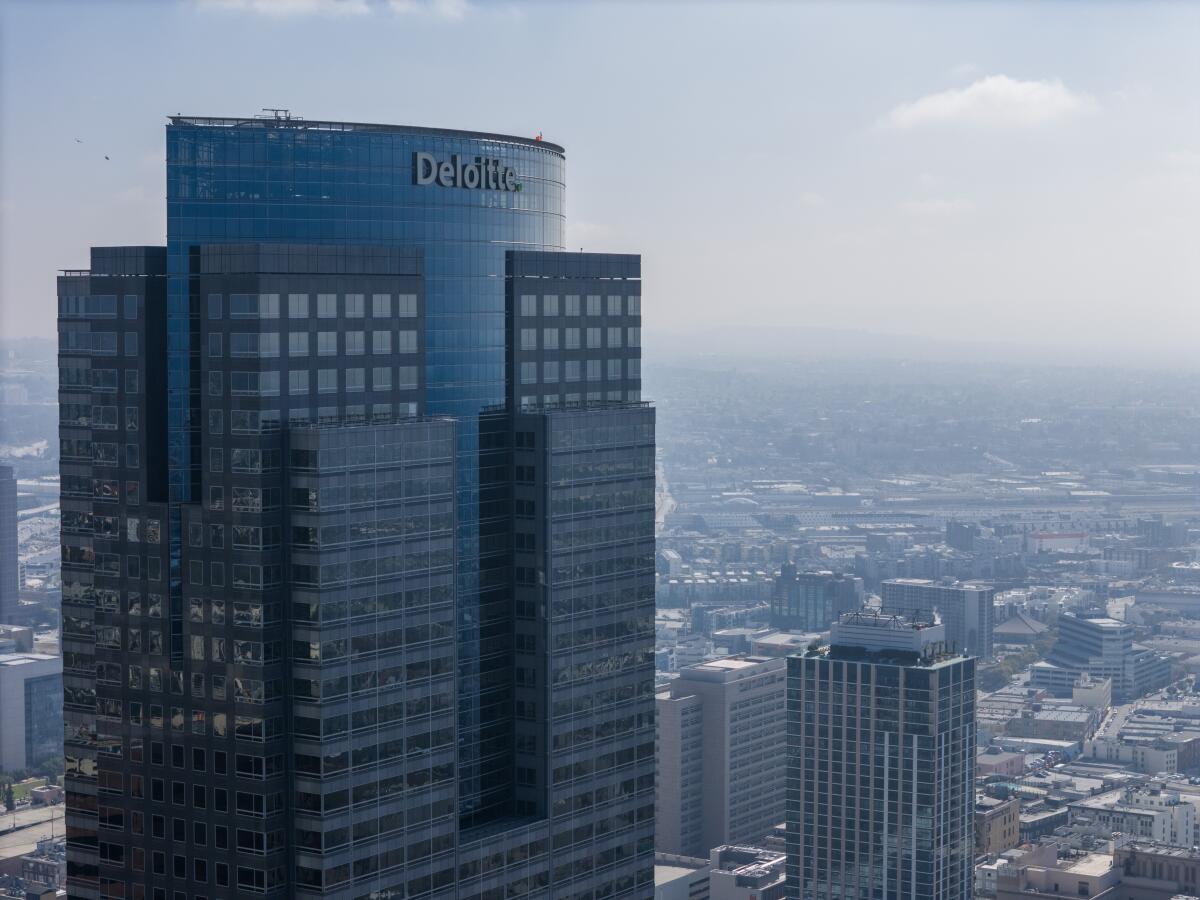
Banavalkar said the U.S. Bank Tower and the Figueroa at Wilshire skyscraper — he was the structural engineer of both — also use a dual structural system.
Steel frame buildings have suffered significant damage in the U.S. and abroad. In 1995, one story of a steel building collapsed during a magnitude 6.9 quake in Kobe, Japan. And one-third of 630 modern steel buildings in the heavily shaken area were severely damaged, according to a report from the U.S. Geological Survey.
That 2008 report, titled “The Shakeout Scenario,” quoted structural engineers as saying that “the collapse of some pre-1994 welded-steel-moment-frame buildings is a credible scenario,” and it is plausible that five steel moment frame high-rise buildings in Southern California could collapse in a hypothetical magnitude 7.8 earthquake on the San Andreas fault.
In such a quake, many buildings would face nearly 2 minutes of shaking, far longer than the seven to 15 seconds of movement felt in 1994, the USGS said.
The guide to earthquake readiness and resilience that you’ll actually use.
Although the Northridge quake and 1989’s magnitude 6.9 Loma Prieta earthquake were plenty scary for many people, their epicenters were quite far from the city centers of San Francisco and Los Angeles, bringing those downtowns only “strong” or “very strong” shaking. That type of movement — as defined by the Modified Mercalli Intensity Scale — is milder and less damaging than the “severe” shaking felt in a section of Santa Cruz County in 1989 and the “violent” shaking felt in part of the suburban San Fernando Valley in 1994.
Unreinforced brick buildings, nonductile concrete buildings and unretrofitted tilt-up buildings are considered far more dangerous than steel moment frame buildings, and there are plenty of examples in California where those types of structures have collapsed. “But that doesn’t mean they [steel moment frame buildings] shouldn’t be evaluated and retrofitted,” Cocke said.
Should even just one steel moment frame building collapse in an earthquake, the results would be catastrophic. The hypothetical five such buildings that might completely collapse during a powerful quake could have 5,000 people inside of them, the USGS said.
The question is whether the Gas Company Tower would need a seismic retrofit to handle a strong quake. The fact that there’s a braced core helps. Generally speaking, that provides stiffness and strength to help the building deal with side-to-side shaking, Cocke said.
A modern seismic analysis of the building would be helpful because of the many changes in seismic assumptions since it was designed. Scientists say ground shaking from an earthquake now can be much worse than previously thought, and buildings in downtown Los Angeles and San Francisco have not been tested against the kind of severe shaking we now know is possible.
“The [seismic] loads that these older buildings were designed to were much lower in the ‘80s,” said Daniel Zepeda, a structural engineer with Degenkolb Engineers.
Monday’s magnitude-4.4 earthquake caused little damage and no known injuries. But the temblor left many rattled.
Other advances since the skyscraper was constructed include the discovery of a new earthquake fault.
It was only in 1999 that scientists discovered the Puente Hills thrust fault system, which is underneath swaths of downtown L.A., southeast L.A. County, the San Gabriel Valley and northern Orange County. That fault system is capable of a magnitude 7.5 earthquake, and one simulation estimates such an event could kill 3,000 to 18,000 people.
It’s unclear how much a retrofit of the skyscraper would cost if it is needed, but because the Gas Company Tower has a dual structural system that incorporates a braced core, it could ultimately be cheaper than if it had only a steel moment frame, Cocke said.
Although some have praised the county for moving to buy the skyscraper at a “firesale” price and have argued that such a sale will reinvigorate downtown, most members of the Board of Supervisors have stayed quiet on the proposal, which has been negotiated by the Chief Executive Office. Supervisor Janice Hahn has been the lone exception, arguing that the county has no business leaving the Civic Center, where many of L.A.’s government buildings are clustered.

The Hall of Administration was named after Hahn’s father, the late Kenneth Hahn, as he retired after a record 10 terms as a supervisor. A representative of South Los Angeles from 1952 to 1992, he died in 1997 at age 77.
The Chief Executive Office said the county owns some steel-framed buildings, but it has not created a comprehensive list like it has for its nonductile concrete buildings. There are no immediate plans to seismically upgrade steel buildings since the focus is on retrofitting the riskier structures, officials said.
Moving the county offices to the Gas Company Tower does not solve the problems with the county’s seismically vulnerable nonductile concrete buildings, and questions remain as to whether they should be retrofitted, demolished, sold or left empty. The Board of Supervisors voted last year to ask officials to prepare new rules requiring nonductile concrete buildings owned by the county, as well as any in unincorporated areas, to be retrofitted.
Although the Hall of Administration is the most prominent, the county owns other nonductile concrete facilities. Among the most crucial: the Department of Medical Examiner, where officials perform autopsies; and the headquarters for the departments of public health and health services.
Even if empty, the collapse of just one building could injure or kill people and motorists nearby and possibly cast a pall over its neighbors — such as the Civic Center — for years.
More to Read
Sign up for This Evening's Big Stories
Catch up on the day with the 7 biggest L.A. Times stories in your inbox every weekday evening.
You may occasionally receive promotional content from the Los Angeles Times.
